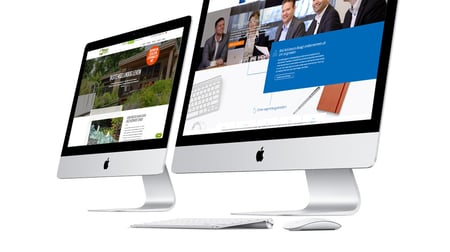
The menu structure of your website can be compared to signage on the street or in a shopping mall. You cannot reach your destination without knowing where you are currently located. For this reason, navigation in web design is one of the most important, if not the most important, factor(s) in website marketing. It has a significant impact on the user-friendliness of your B2B website and the experience of your visitors. If visitors cannot find their way through your site and navigate quickly enough, they will disengage. As a result, you miss out on (potential) customers. In this blog article, we will share with you 'the best practices' for an effective menu structure.
A website structure gives your visitors direction
Visitors who access a website do so with a purpose. They are looking for specific information, want to view products and/or services, or aim to get in touch with your company. The menu structure serves as a guide for website visitors, providing them with direction. They should be able to find what they are looking for. Therefore, when developing a website, it is important to create a user-friendly and well-thought-out navigation structure.
Therefore, before the development of your site, carefully consider what should be included in the menu structure. Which items will appear in the navigation bar, what will be the order, and is there a need for a secondary or submenu, for example? A website's menu structure can be simple, consisting of just a few items, or it can be complex with an extensive underlying architecture. Constructing a website structure is a matter of clever puzzle-solving, making choices, and testing.
Choose a maximum of 7 menu items for your website.
A main menu is typically located in the header of a website. Nowadays, every website is responsive, meaning it can be viewed on mobile phones and tablets. This requires taking into account that the menu structure is visible and suitable for all devices. For this reason, and to keep it organized, we recommend limiting the navigation structure to a maximum of seven main menu items. Our short-term memory can only remember about seven items as well.
By keeping the main menu organized, visitors can quickly scan the structure and immediately see the most important items. Additionally, when you remove menu items, the remaining items become more relevant. Challenge yourself to limit your menu structure to as few items as possible, with a maximum of seven. With too many menu items, visitors won't know where to look/click, lose track, and are more likely to disengage.
The order of menu items in the menu structure
In reality, there is no standard menu structure. However, there are several things that have emerged from psychology research and user experiences that you can apply to your website menu. For example, research shows that attention is highest for things at the beginning and end of something. Therefore, place important items such as your home button and contact button at the beginning and end of the menu structure. These are common locations. In addition, there are several other 'best practices' to consider for the navigation structure:
Home-button
The home-button is an element that is sometimes overlooked in a menu structure. However, this is an important element because it allows users to navigate back to the homepage of the website, which serves as the starting point. The home button can also be presented in the form of a house icon. Always place the home button at the beginning of the menu.
Contact button
The contact button is an important component of your website. It allows visitors to get in touch with you. It is common practice to place the contact button at the end of the menu. That is where visitors expect to find it.
The core
After the home button, it is advisable to include your products, services, and the core activities of your organization at the front of the menu. Next, you can display items such as approach, services, and/or references. Following that, menu items like About Us, Team, Vacancies, and Partners should be included. If applicable, you can also include a blog/news section in between.
Secondary menu
If your main menu, or primary menu, already consists of seven items, you can create a so-called secondary menu. This is a second navigation bar that sits above the main menu. In the secondary menu, you can include items such as an About Us page, a blog, or news section. Additionally, it is common to include language flags, a login option, and phone number in the secondary menu.
Footer
Legal buttons, such as disclaimers or terms and conditions, are typically placed in the footer of a website.
For each website, it is important to consider what should stand out the most. After all, one organization is not the other, and the target audience of one company is looking for something different than the target audience of another company. However, it is clear that the most important topics of the site should be included in the main menu simply because visitors expect to find them there.
Internet users are accustomed to certain standards.
Internet users are accustomed to certain ways of navigating. For example, visitors expect a horizontal navigation at the top of the website because it is common. Placing the navigation structure in a standard position makes a website more user-friendly. A common mistake is trying to be creative with the menu, deviating from the standard, which leads to a lack of recognition and disengaged visitors. Try to avoid that.
Furthermore, there are a few other common methods regarding a website structure that are almost considered self-evident:
Standardize the menu for each page
Standardize your main menu navigation for your whole website. In other words, use the same navigation on each page and do not show an adapted navigation on each page. That is confusing for visitors. After all, a visitor loves consistency.
Menu items need to be descriptive
Menu items in a main menu need to be descriptive. Tell visitors what you do and use terms your target group understands. Avoid using difficult jargon. It is important that your target group knows what you mean. Be mindful that you keep the menu items short and sweet.
Navigation links instead of buttons
Always use navigation links in your main menu instead of buttons. Buttons are:
- Unreadable by search engines
- More difficult to adapt
- Slower; buttons load more slowly than links
Highlight or mark the active menu item
Indicate to a visitor where he is located on your website by highlighting or marking the menu item. You can provide the menu item with a different color or you can underline it.
Create a successful website
In this blog article, we have provided you with guidance on website menu structure using 'best practices'. As mentioned, website navigation is different for each website. It should align with your company, your target audience, and fit into your site's webdesign. If you would like more information about the menu structure, assistance in developing it, or want to us to create a website for you, please get in touch.

